It is the final days of 2018, and I just completed the 30-book reading challenge I gave myself at this time last year. In all, I read 20 of those books in either physical print book form or on my iPad (through iBooks or the Kindle app) and I “read” the other 10 books through Audible. That’s an excellent combination because with my travels, I find myself in planes, trains, and automobiles. When I can’t sit down to read a book (such as when driving or maybe even at the gym), I can listen to one. It really helps me maximize my time and certainly helped in knocking down more books in the most efficient manner possible.
In all I read 11,725 pages through these 30 books. Of those, 5,850 pages were “read” by listening to the books via Audible, while the remaining 5,876 were read in the good ol’ fashion traditional way. So roughly half the pages were listened to and half physically read. This also means that the average book was 390 pages long.
The other thing that helped with completing these many books is that I was often in the middle of at least a few different books at one time. I find this advantageous in that sometimes you’re not in the mood for a specific book, but you may be in the mood for a different one. So, this also helps in keeping the reading going, rather than choosing to do something a little lazier.
With that said, 30 books in one year was a lofty goal and in order to read these many books (and some were very long books), I had to sacrifice other things like television shows, movies, sporting events, and listening to podcasts. But, I gave myself the challenge and wanted to complete it. I learned when you set a goal and are laser focused on it, you can really accomplish anything.
 While I already gave a review of the first 8 books of 2018 and the next 7 books of 2018 in early blog posts, here I recap 14 of the remaining 15 books. I also put up a special post about one of my favorite books of the year, 12 Rules for Life by Jordan Peterson. That book was so profound that I thought it worth its own post as to showcase some of the main thoughts from each of his “12 Rules.”
While I already gave a review of the first 8 books of 2018 and the next 7 books of 2018 in early blog posts, here I recap 14 of the remaining 15 books. I also put up a special post about one of my favorite books of the year, 12 Rules for Life by Jordan Peterson. That book was so profound that I thought it worth its own post as to showcase some of the main thoughts from each of his “12 Rules.”
Which were my favorite books of the year? It’s hard to choose, but I’ll give you a few of my favorites: 12 Rules for Life by Jordan Peterson, Jerusalem: The Biography by Simon Sebag Montefiore, and Gone With The Wind by Margaret Mitchell. This leaves so many more on the table such as The Vanishing American Adult by Ben Sasse, Unbroken by Laura Hillenbrand, and The Alchemist by Paul Coelho. I can tell you every book I read this year was great – a mix of fiction and nonfiction, as well as a diverse group within the nonfiction category.
Of the final 15 books of 2018, I read four books related to Israel since I took an amazing journey there this August. I read two books about Florida, where I live and was born and raised. And I read several spiritual and philosophical books that really helped me on my own personal faith journey.
Below are short synopses of 14 of the final 15 books this year. Like I said, the other one, 12 Rules for Life, has its own post. These complete my 30 books for this year. In 2019, I plan to continue reading, but I’ll be bringing the goal down to 24 as to allow time for other things in life, and of those 24, I don’t plan to do quite so many long ones (especially the three marathon books I did by Audible – two were over 40 hours and one was over 50 hours!)
 Before I go on reviewing the books below, I want to say something else about reading. Books enlighten us. Stories – whether fiction, biography, or memoirs, let us in to the experiences of others. And then we realize we also live in a world that has always been in conflict and has people living from a huge variety of perspectives. History helps us understand why things are the way they are today. Along these lines, I enjoyed two sentiments from authors I read this final part of the year.
Before I go on reviewing the books below, I want to say something else about reading. Books enlighten us. Stories – whether fiction, biography, or memoirs, let us in to the experiences of others. And then we realize we also live in a world that has always been in conflict and has people living from a huge variety of perspectives. History helps us understand why things are the way they are today. Along these lines, I enjoyed two sentiments from authors I read this final part of the year.
The first was from Simon Sebag Montefiore when he said, about his “biography” of the city of Jerusalem: “If this book has any mission, I passionately hope that it might encourage each side to recognize and respect the heritage of the Other.” The second was from the foreword of The Alchemist by Paul Coelho. He said, “I am reminded that it is within our power to build a bridge to be crossed. Even if my neighbor doesn’t understand my religion or understand my politics, he can understand my story. If he can understand my story, then he’s never too far from me. It is always within my power to build a bridge. There is always a chance for reconciliation, a chance that one day he and I will sit around a table together and put an end to our history of clashes. And on this day, he will tell me his story and I will tell him mine.”
We all need to read a little bit more – if simply to hear more stories about our world and those who live in. Reading helps us learn, understand, and ultimately reflect how to better ourselves, our relationships with others, and the world we inhabit for just a short time.
And now on to the reviews…
Six Books About Two Places: Florida and Israel
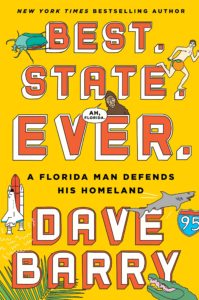 Best State Ever: A Florida Man Defends His Homeland is a hilarious book by humor writer Dave Barry. He claims that Florida, with all its weird stories and weird people, is truly the best state ever. Nothing is ever boring here, that’s for sure. And Dave Barry’s writing takes the strange and makes it funny. In this book, he visits 9 unique places in Florida – from the legend of the Skunk Ape to the active adult community of The Villages and the hottest nightclub on South Beach. I literally laughed out loud on every page, while also learning some things about some interesting people and places in modern Florida.
Best State Ever: A Florida Man Defends His Homeland is a hilarious book by humor writer Dave Barry. He claims that Florida, with all its weird stories and weird people, is truly the best state ever. Nothing is ever boring here, that’s for sure. And Dave Barry’s writing takes the strange and makes it funny. In this book, he visits 9 unique places in Florida – from the legend of the Skunk Ape to the active adult community of The Villages and the hottest nightclub on South Beach. I literally laughed out loud on every page, while also learning some things about some interesting people and places in modern Florida.
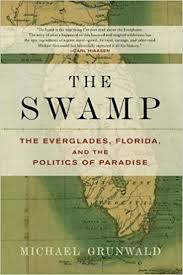 The Swamp: The Everglades, Florida, and the Politics of Paradise by Michael Grunwald is surely the best history of the Everglades ever put together. It gives you a history of this unique natural wonder, from the time well before Europeans made their way to the Americas, through to the industrial era when the way man approached nature was to “conquer” it. For the Everglades, and much of its history, that meant that the swamp must be drained and the land reclaimed for human use. Considering what we know now about all the problems those earlier settlers caused by treating the Everglades as a wild place of nature that must be tamed, drained, and settled upon, it was almost hard to read this, but it also helps us understand how even environmentalists approached nature at that time.
The Swamp: The Everglades, Florida, and the Politics of Paradise by Michael Grunwald is surely the best history of the Everglades ever put together. It gives you a history of this unique natural wonder, from the time well before Europeans made their way to the Americas, through to the industrial era when the way man approached nature was to “conquer” it. For the Everglades, and much of its history, that meant that the swamp must be drained and the land reclaimed for human use. Considering what we know now about all the problems those earlier settlers caused by treating the Everglades as a wild place of nature that must be tamed, drained, and settled upon, it was almost hard to read this, but it also helps us understand how even environmentalists approached nature at that time.
Grunwald then brings us up to the present time, including the efforts led by the great environmentalist Marjorie Stoneman Douglas and politicians of all stripes trying to do what they can to salvage what we have left of the Everglades. So far, we’re back on the right track, but there’s a lot of damage that’s been done that can never return the Everglades to the way it was before settlers came to Florida. This is a must-read book for every Floridian and for anyone who cares to learn about man’s relationship with nature.
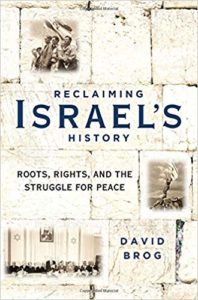 Reclaiming Israel’s History: Roots, Rights, and the Struggle for Peace by David Brog is a book that really is a great narrative that brings us up to speed on the history and conflict of the Jews and Arabs in modern day Israel. This is a fairly recent book, published in 2017, that gives a full history of Jews, Christians, and Muslims and the establishment of the State of Israel.
Reclaiming Israel’s History: Roots, Rights, and the Struggle for Peace by David Brog is a book that really is a great narrative that brings us up to speed on the history and conflict of the Jews and Arabs in modern day Israel. This is a fairly recent book, published in 2017, that gives a full history of Jews, Christians, and Muslims and the establishment of the State of Israel.
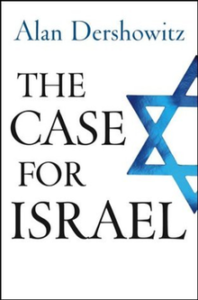 The Case for Israel by Alan Dershowitz, published in the midst of the Second Intifada in 2004, is a good complement to Brog’s book. Dershowtiz has a very nice introduction and conclusion to give the book context, but most of the book lays out about 32 “accusations” by those who oppose Israel and/or by those who want to see the State of Israel eradicated. What I like about this book is the way it focuses you on some of the central arguments for “the other side,” arguments Dershowitz gives a fair hearing to before he rips each and every one of them apart like a good lawyer would. In each of the 32 “accusations,” he states the accusation and the accusers, then he counters with the reality, and the proof of that reality. The book can be dry at times, but it’s a good primer for anyone who wants to make the case for Israel. Brog’s is the story, Dershowitz is the arguments – the case – for Israel.
The Case for Israel by Alan Dershowitz, published in the midst of the Second Intifada in 2004, is a good complement to Brog’s book. Dershowtiz has a very nice introduction and conclusion to give the book context, but most of the book lays out about 32 “accusations” by those who oppose Israel and/or by those who want to see the State of Israel eradicated. What I like about this book is the way it focuses you on some of the central arguments for “the other side,” arguments Dershowitz gives a fair hearing to before he rips each and every one of them apart like a good lawyer would. In each of the 32 “accusations,” he states the accusation and the accusers, then he counters with the reality, and the proof of that reality. The book can be dry at times, but it’s a good primer for anyone who wants to make the case for Israel. Brog’s is the story, Dershowitz is the arguments – the case – for Israel.
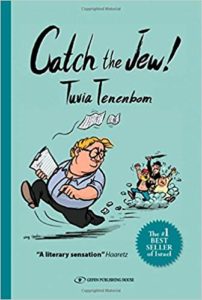 Catch the Jew by Tuvia Tenenbom was a book recommended to me by a new Jewish friend I met on our plane trip to Israel. He is an American, but has spent a lot of time in Israel and found Tuvia’s book to be one that tells the most truth about the people living in the land of Israel. It’s also absolutely hilarious. Tuvia is a journalist of German descent, now living in New York. He embeds himself in many different communities in Israel – liberal, conservative, orthodox, Jewish, Christian, Muslim, and secular. He points out the truths, the idiosyncrasies, the contradictions. Many things in Israel have contradictions and there are layers of depth to every story. Tuvia really brings them to light. This book was even more interesting after visiting Israel, but it’s also one that will surely allow me to see things with much more open eyes on any future trips to the Holy Land.
Catch the Jew by Tuvia Tenenbom was a book recommended to me by a new Jewish friend I met on our plane trip to Israel. He is an American, but has spent a lot of time in Israel and found Tuvia’s book to be one that tells the most truth about the people living in the land of Israel. It’s also absolutely hilarious. Tuvia is a journalist of German descent, now living in New York. He embeds himself in many different communities in Israel – liberal, conservative, orthodox, Jewish, Christian, Muslim, and secular. He points out the truths, the idiosyncrasies, the contradictions. Many things in Israel have contradictions and there are layers of depth to every story. Tuvia really brings them to light. This book was even more interesting after visiting Israel, but it’s also one that will surely allow me to see things with much more open eyes on any future trips to the Holy Land.
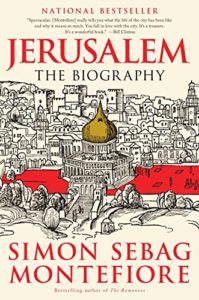 Jerusalem: The Biography by Simon Sebag Montefiore may have been the best book I read in 2018. Following my trip to Israel in August, this book was recommended to me by a friend who traveled there twice before. It’s a colossal 704-page book, that takes you through thousands of years of Jerusalem’s history from King David to the formation of the State of Israel up to the Six-Day War in 1967. There is an amazing prologue to the book that details the destruction of the Temple in Jerusalem by the Romans in 70 AD – over 10,000 people died in the Temple alone during that siege. To this day, this site is one of the most sacred spaces for Jews, Christians, and Muslims, and it’s central to understanding Jerusalem and all the contests for this Holy City. The prologue goes beyond the 1967 war and brings us almost up to the present (this book was published in 2015).
Jerusalem: The Biography by Simon Sebag Montefiore may have been the best book I read in 2018. Following my trip to Israel in August, this book was recommended to me by a friend who traveled there twice before. It’s a colossal 704-page book, that takes you through thousands of years of Jerusalem’s history from King David to the formation of the State of Israel up to the Six-Day War in 1967. There is an amazing prologue to the book that details the destruction of the Temple in Jerusalem by the Romans in 70 AD – over 10,000 people died in the Temple alone during that siege. To this day, this site is one of the most sacred spaces for Jews, Christians, and Muslims, and it’s central to understanding Jerusalem and all the contests for this Holy City. The prologue goes beyond the 1967 war and brings us almost up to the present (this book was published in 2015).
I thought there was no more fitting way to describe how the author, Montefiore, sums up the book in the prologue then with this statement: “Jerusalem’s history is a chronicle of settlers, colonists and pilgrims, who have included Arabs, Jews, and many others, in a place that has grown and contracted many times … If this book has any mission, I passionately hope that it might encourage each side to recognize and respect the heritage of the Other … For 1,000 years, Jerusalem was exclusively Jewish; for about 400 years, Christian; for 1,300 years, Islamic; and not one of the three faiths ever gained Jerusalem without the sword, the mangonel or the howitzer. Their nationalist histories tell a rigid story of inevitable progressions to heroic triumphs and abrupt disasters, but in this history I have tried to show that nothing was inevitable, there were always choices. The fates and identities of Jerusalemites were rarely clear cut. Life in Herodian, Crusader, or British Jerusalem was always just as complex and nuanced as life is for us today.”
Three Books of Faith Journeys
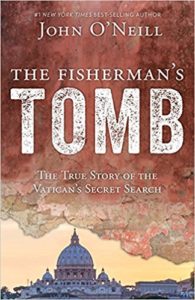 The Fisherman’s Tomb by John O’Neill was actually recommended to me earlier this year by someone with the Strake Foundation in Houston, Texas. The foundation is named for the Strake family, which first came to prominence through the patriarch of the family, George Strake, a philanthropist, who was born into poverty in St. Louis and after much hard work in the oil industry discovered the third largest oil well in the United States, in Houston, in the 1930s. It wasn’t until many months later that I actually finally cracked open this book. And when I did, I kept reading it until, only four hours later, I finished it. It was a pretty fast read but I couldn’t put it down. What a story!
The Fisherman’s Tomb by John O’Neill was actually recommended to me earlier this year by someone with the Strake Foundation in Houston, Texas. The foundation is named for the Strake family, which first came to prominence through the patriarch of the family, George Strake, a philanthropist, who was born into poverty in St. Louis and after much hard work in the oil industry discovered the third largest oil well in the United States, in Houston, in the 1930s. It wasn’t until many months later that I actually finally cracked open this book. And when I did, I kept reading it until, only four hours later, I finished it. It was a pretty fast read but I couldn’t put it down. What a story!
George Strake quietly funded the Vatican’s secret search for St. Peter’s tomb, a search that began in 1939. This is a story that involves only a handful of people and started as Mussolini and Hitler wreaked havoc on Italy and Europe during WWII. It also involves a woman who was one of the top archeologists of the twentieth century and a few priests who also helped secretly save over 850,000 Jews from Hitler’s holocaust. What a story!
The one thing that really struck me was that Pope Pius XII, who ordered the excavation (after they discovered some previously unknown tombs underneath St. Peter’s basilica) took a real risk. What if this excavation turned out to prove St. Peter wasn’t buried there? In a time when science was seen as opposed to religion, Pope Pius XII had confidence – he had faith! – that science can confirm our faith, and he let the new science of archeology go forth. Ultimately, it took decades for the full truth to be revealed. Through their scientific discovery, our faith is confirmed and we learned even more about the early underground Christian community which survived the persecutions of the Roman Empire before blossoming into the world’s largest religion.
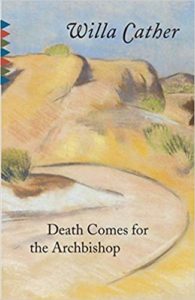 Death Comes for the Archbishop by Willa Cather is a fictional story that is an incredible journey by a priest that is sent into the American wilderness in the mid-1800s, to the area that now encompasses places like New Mexico and Arizona, and parts of northern Mexico. The Catholic Church is the universal church and the Christian religion is one that has a missionary zeal to bring the truth of Christ to all, including natives. The area that Father Jean Marie Latour is sent to is part of the United States but the people are of a different culture: mostly Mexican and Indian in their customs and their beliefs. Coincidentally, I visited New Mexico this year, but that’s not why I put this book on my list. I also “read” this book (via Audible) shortly after visiting New Mexico and the story took on new meaning for me due to that, I believe. This is a story of faith, but also a story of a particular people in a particular time and place. All delivered through this work of fiction.
Death Comes for the Archbishop by Willa Cather is a fictional story that is an incredible journey by a priest that is sent into the American wilderness in the mid-1800s, to the area that now encompasses places like New Mexico and Arizona, and parts of northern Mexico. The Catholic Church is the universal church and the Christian religion is one that has a missionary zeal to bring the truth of Christ to all, including natives. The area that Father Jean Marie Latour is sent to is part of the United States but the people are of a different culture: mostly Mexican and Indian in their customs and their beliefs. Coincidentally, I visited New Mexico this year, but that’s not why I put this book on my list. I also “read” this book (via Audible) shortly after visiting New Mexico and the story took on new meaning for me due to that, I believe. This is a story of faith, but also a story of a particular people in a particular time and place. All delivered through this work of fiction.
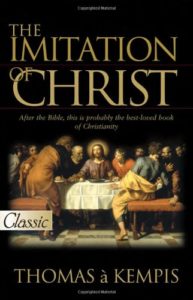 The Imitation of Christ by Thomas a’Kempis is a great devotional that is considered to be the most loved book by Christians after the Bible. Published around 1427, it still speaks volumes to us today. You can read this book for just a few minutes each day, as it is divided into many different very small “chapters” or sections focused on one thing to meditate on at a time. I read it very slowly over the course of about six months. Here is one passage that serves as an example of the kind of peace and fulfillment that this book helps bring through meditating on some of its thoughts about our relationship to the Lord and to others: “Endeavor to do the will of another rather than your own. Choose always to have less rather than more. Seek always the lowest place and consider others better than yourself. Wish and pray always that the will of God be completely fulfilled in you. Behold, such a person enters into the realm of peace and rest.”
The Imitation of Christ by Thomas a’Kempis is a great devotional that is considered to be the most loved book by Christians after the Bible. Published around 1427, it still speaks volumes to us today. You can read this book for just a few minutes each day, as it is divided into many different very small “chapters” or sections focused on one thing to meditate on at a time. I read it very slowly over the course of about six months. Here is one passage that serves as an example of the kind of peace and fulfillment that this book helps bring through meditating on some of its thoughts about our relationship to the Lord and to others: “Endeavor to do the will of another rather than your own. Choose always to have less rather than more. Seek always the lowest place and consider others better than yourself. Wish and pray always that the will of God be completely fulfilled in you. Behold, such a person enters into the realm of peace and rest.”
Three Stories to Learn From
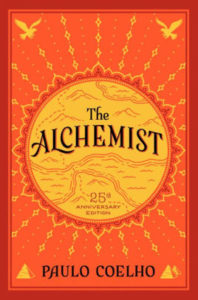 The Alchemist by Brazilian author Paul Coelho is a great work of fiction that I had not heard of until it was recommended to me by a young entrepreneur who I met through one of my podcasts (he reads it every year). But I have since learned that many leaders from many professions have read it since it was released about 25 years ago. It is a fictional story about a boy who goes searching for his treasure, but really for his purpose in life. This book is filled with profound truths and it’s a relatively short, fun read. I highlighted many great lines that the characters speak to one another, lines I have gone back to and contemplated about my own journey through life. But here’s a few I jotted down one day: “No matter what he does, every person on earth plays a central role in the history of the world. And normally he doesn’t know it … God has prepared a path for everyone to follow. You just have to read the omens that he left for you …” The closer one gets to realizing his Personal Legend, the more that Personal Legend becomes his true reason for being.” May we all find our Personal Legend. Look for the omens!
The Alchemist by Brazilian author Paul Coelho is a great work of fiction that I had not heard of until it was recommended to me by a young entrepreneur who I met through one of my podcasts (he reads it every year). But I have since learned that many leaders from many professions have read it since it was released about 25 years ago. It is a fictional story about a boy who goes searching for his treasure, but really for his purpose in life. This book is filled with profound truths and it’s a relatively short, fun read. I highlighted many great lines that the characters speak to one another, lines I have gone back to and contemplated about my own journey through life. But here’s a few I jotted down one day: “No matter what he does, every person on earth plays a central role in the history of the world. And normally he doesn’t know it … God has prepared a path for everyone to follow. You just have to read the omens that he left for you …” The closer one gets to realizing his Personal Legend, the more that Personal Legend becomes his true reason for being.” May we all find our Personal Legend. Look for the omens!
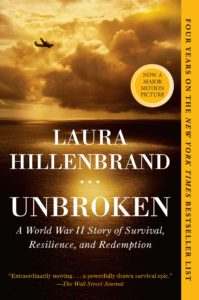 Unbroken by Laura Hillenbrand is truly one of the most amazing stories of survival I’ve ever read and heard. I saw the original movie when it came out about five years ago. There is a sequel out now (Unbroken: Path to Redemption) that completes the latter park of Hillenbrand’s book, which I watched after reading this book. This is the story of Louis Zamperini, an Olympic runner, who competed, at the age of 19, in the 1936 Olympics, “Hitler’s Olympics,” in Berlin. Louis actually shook Hitler’s hand at one point. While he didn’t win any medals that year, he did run the fastest last lap in the 1500-meter race – setting an Olympic record. While he goes back home to train for the next Olympics slated for 1940, it was never to be. That Olympics was supposed to be in Tokyo (and later was planned to be moved to Helsinki). But with the outbreak of WWII, the Olympics were canceled. Louis enlisted in the Air Force. His plane was shot done in the Pacific.
Unbroken by Laura Hillenbrand is truly one of the most amazing stories of survival I’ve ever read and heard. I saw the original movie when it came out about five years ago. There is a sequel out now (Unbroken: Path to Redemption) that completes the latter park of Hillenbrand’s book, which I watched after reading this book. This is the story of Louis Zamperini, an Olympic runner, who competed, at the age of 19, in the 1936 Olympics, “Hitler’s Olympics,” in Berlin. Louis actually shook Hitler’s hand at one point. While he didn’t win any medals that year, he did run the fastest last lap in the 1500-meter race – setting an Olympic record. While he goes back home to train for the next Olympics slated for 1940, it was never to be. That Olympics was supposed to be in Tokyo (and later was planned to be moved to Helsinki). But with the outbreak of WWII, the Olympics were canceled. Louis enlisted in the Air Force. His plane was shot done in the Pacific.
He and two fellow servicemen survived over 50 days at sea, facing starvation, storms, sharks, and even Japanese pilots shooting at them. It’s simply incredible. Then they are captured, imprisoned, and tortured for the better part of two years. But he survives and is eventually liberated when the Americans defeat the Japanese after years of fighting. The last part of the book, the one that the second movie is based upon, follows Louis’ return home, his bouts with PTSD, alcoholism, and his finding peace through his redemption in Christ. He lived well into his 90s and died just shortly before this book and movies were released. There is a twist at the end I won’t tell you about, but let’s just say it involved his former prison guard who tortured him. This story captured my attention, moved me, and made me grateful for people like Louis Zamperini who teach us that if you persist, you can never truly be broken.
 The Rising Sun: The Decline and Fall of the Japanese Empire, 1936-1945 by John Toland is a marathon that details everything from the time the Japanese entered the conflicts with China and the United States, the islands in the Pacific, and their alliance with Germany, Italy, and the Axis powers in WWII. The most interesting part of this book is that it’s mostly told from the perspective of the Japanese, who were our greatest direct enemy in WWII, considering they brought the United States into the war by their surprise and savage attack on Pearl Harbor, which took the lives of over 2,335 Americans in a matter of hours – not to mention the 1,143 who were injured and the many ships that were destroyed.
The Rising Sun: The Decline and Fall of the Japanese Empire, 1936-1945 by John Toland is a marathon that details everything from the time the Japanese entered the conflicts with China and the United States, the islands in the Pacific, and their alliance with Germany, Italy, and the Axis powers in WWII. The most interesting part of this book is that it’s mostly told from the perspective of the Japanese, who were our greatest direct enemy in WWII, considering they brought the United States into the war by their surprise and savage attack on Pearl Harbor, which took the lives of over 2,335 Americans in a matter of hours – not to mention the 1,143 who were injured and the many ships that were destroyed.
A few things were apparent in this story: the Japanese military really brought their country into this war. Most people, including the Emperor, did not want to attack the Americans. It’s also apparent that Japan felt they were a supreme race (in a different way than Hitler believed in the Aryan race, but still signifying that they believed they were superior and that they were destined to control most of East Asia). However, they also felt that it was their duty to protect those of the yellow race – including other Asians who were not Japanese – from the encroachment of Europeans and Americans who were having increasing influence in Asia both militarily and commercially.
In other words, the Japanese felt threatened and they felt like their attack on Pearl Harbor was necessary to gain the upper hand in a conflict they saw was inevitably going to come. They were wrong in so many ways. The biggest strength the United States had was not just in our military capabilities, but in our vast amount of resources that could fund and supply the war effort. Later, we would also have higher technology that would unload a firestorm of weapons (including the first two atomic bombs) on Japan, including many civilians who would perish. It also brings you into the mindset of the Japanese: in their culture, it was shameful to surrender on any level – which is why so many committed suicide, with some doing so through infamous kamikaze attacks. This book was a marathon. I “read” it over Audible (41 hours!) I found many parts of it really interesting, but I also found many other parts, the very detailed individual battles of every island in the Pacific, a bit of a marathon to slug through. I decided to “read” this book right after I finished “Unbroken” so that I could get the story from the Japanese side and see the full context of the war that Louis Zamperini and the Americans were brought into.
Two Books from National Review Institute Fellows
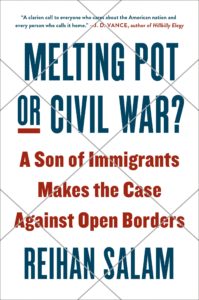 Melting Pot or Civil War? A Son of Immigrants Makes the Case Against Open Borders is a book by my National Review Institute colleague Reihan Salam. It was published in September of this year and I was privileged to receive an advance copy as I would be promoting his work and attending a number of events in Florida and Texas where Reihan would be speaking to many of our supporters and friends. This gave me the opportunity to review the book for The Federalist, so you can read a much fuller review there.
Melting Pot or Civil War? A Son of Immigrants Makes the Case Against Open Borders is a book by my National Review Institute colleague Reihan Salam. It was published in September of this year and I was privileged to receive an advance copy as I would be promoting his work and attending a number of events in Florida and Texas where Reihan would be speaking to many of our supporters and friends. This gave me the opportunity to review the book for The Federalist, so you can read a much fuller review there.
But to be quick here, I would say that the release of Reihan’s book is as timely as ever and it is getting tons of attention. He argues that the real choice we have in our immigration debate “is whether we see the immigrants we welcome to our shores as permanent strangers to whom we have no obligation other than to deliver them from the relative poverty of their homelands, or as free and equal citizens to whom we are pledging our loyalty in this generation and those to come.” If we are to live up to the standards of America’s principles, as Reihan hopes we do, we would certainly want to move in a direction more towards the second choice.
But in order to do this, we have to revisit our current public policy prescriptions for immigration. That means we need to set some real limits on immigration and move towards a more skills-based immigration policy, or a “points” system that rewards these kinds of immigrants. Perhaps the most important element of Salam’s argument is that if we do not create conditions that allow immigrants who come to the United States from all over the world to assimilate and build a melting pot culture, then we are doomed to move towards cultural fragmentation and the polarization of different peoples in our country.
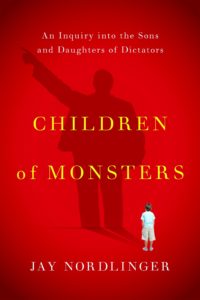 Children of Monsters: An Inquiry into the Sons and Daughters of Dictators was published by my National Review Institute colleague Jay Nordlinger in 2015. This book is truly fascinating in that it is divided into 20 chapters – each focused on a modern dictator and their children. He tells us all the facts about who these people were, both the dictators and their children, and how those children turned out.
Children of Monsters: An Inquiry into the Sons and Daughters of Dictators was published by my National Review Institute colleague Jay Nordlinger in 2015. This book is truly fascinating in that it is divided into 20 chapters – each focused on a modern dictator and their children. He tells us all the facts about who these people were, both the dictators and their children, and how those children turned out.
Some are little monsters of their monstrous fathers – a few of which go on to rule after their fathers, like the Kims of North Korea. Others are defectors – like Svetlana Stalin or some of Fidel Castro’s daughters – who leave their totalitarian countries, where they could have had all the perks of being part of the rich, ruling family and instead find asylum in places like the Untied States and become outspoken critics of their dictator dads. Then there are others who are neither fans nor foes, but just sons and daughters, trying to live as normal a life as possible, given the conditions of their evil parents. What is it like to be born a son or daughter of a dictator? Luckily, for most of us, we will never know. But Jay Nordlinger gives us insight into what must be one of the strangest and problematic situations the human condition has ever known.
